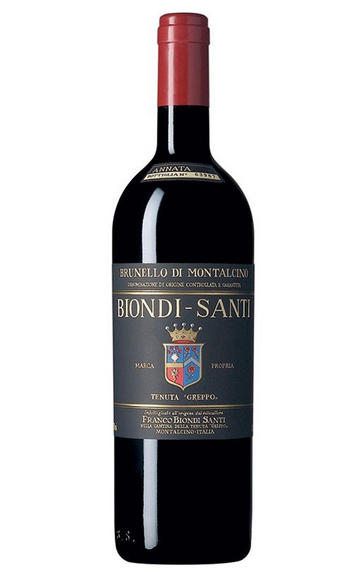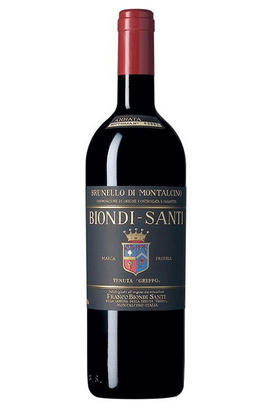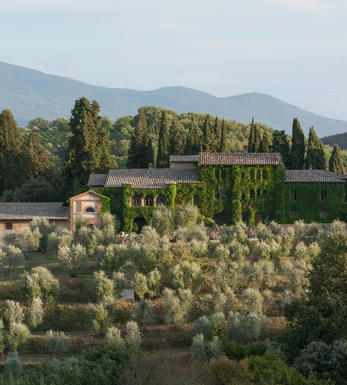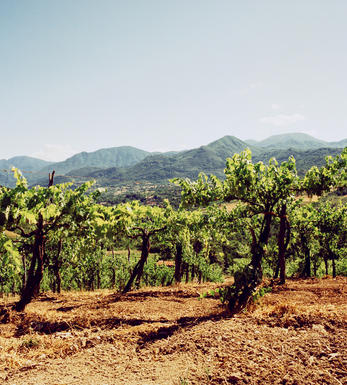
2018 Brunello di Montalcino, Biondi-Santi, Tuscany, Italy

Critics reviews
The 2018 Brunello di Montalcino is gorgeous, floral and finessed, wafting up with a classic Sangiovese profile blending dried rose and black cherries, complicated by dusty earth, worn leather and hints of cedar spice. This shows a beautiful ripeness of fruit, pure and lifted yet potent, with masses of red, wild berries and inner florals that cascade across a core of zesty acidity.
This finishes long and staining with regal tannins and a tart cranberry tinge that lingers on and on. Simply magnificent, the 2018 takes the perfumed character of the vintage and marries perfectly to a core of vividly intense fruit. This is entirely atypical of the vintage and the result of extreme selection that reduced production quantities by 20%.
Drink 2026 - 2036
Eric Guido, Vinous.com (February 2024)
Cool, wet year in which the highest vineyards struggled to reach 12% potential alcohol. Stringent selection was needed. Vinified in a mix of fermenters in terms of both size and material.
Transparent garnet. Very richly autumnal on the nose – quite a cocktail of aromas! Appetising with that slightly agricultural perfume of Sangiovese. Very marked acidity on the palate at this early stage. Not nearly ready. It will need years for the fruit to build in bottle and distract from the early acidity. Very clean, refreshing finish.
Drink 2027 - 2040
Jancis Robinson MW, JancisRobinson.com (March 2024)
So floral on the nose with lavender and lilac coming through clearly. Cherries and peaches with an orange undertone. Medium-bodied with firm and silky tannins that are lightly chewy. Salty undertone to the fruit and hints of cedar and black truffle. Acid-driven. Excellent energy.
Drink after 2025, but already delicious.
James Suckling, JamesSuckling.com (March 2024)
The 2018 was just the second harvest under new ownership for Biondi Santi. CEO Giampiero Bertolini says that picking started late by the estate’s standards. They waited until 25 September, by which time the strong north wind had an opportunity to dry out the vineyards.
The results in the bottle are impressive: cool fragrances of juniper, coriander, pepper and liquorice root leave room for a more subtle violet expression. The palate is decidedly red fruited with pomegranate and sour cherry nuanced by herb flowers, with an underlying stony-mineral crunch. Not lacking in concentration – yet by no means robust – this is graciously weighted. Nor does it have the scratchy bite of a young Biondi Santi Brunello. Instead, tannins are fine-boned and suede-like. Racy acidity is in the driver’s seat bringing focus, linearity and a vibrancy that pops on the finish.
Drink 2026 - 2039
Michaela Morris, Decanter.com (November 2023)
The 2018 Brunello Di Montalcino will be released on March 1, 2024. The color is medium red/garnet, and the nose opens to fresh aromas of orange citrus peel, dusty earth, cranberry, spices, and juniper. Medium-bodied and more linear, it lifts through the palate with fine tannins and a refreshing, mouthwatering finish. It has a great saline feel and is a savory and fresh wine. This is a Brunello I’d love to drink over the next 10 years for its accessibility and refined texture, although I imagine it will also have some real potential for cellaring.
The wines for this report were tasted in January 2024 at the estate with Federico Radi, the Viticulture and Winemaking Director. While the sale of the estate to French group Epi is still fresh on many consumer minds, one thing is certain – Radi is committed to taking this estate into the future while retaining the DNA of Biondi-Santi. His humility and dedication to the greater purpose of the estate is palpable, and as his wines are beginning to come into the market (Radi joined the producer in 2017), there’s a lot to be excited about, despite his not wanting to make a fuss over his own efforts.
As of this year, they have planted new vines on the property, between their iconic Cypress-lined entrance and the Pian Dell’Orino estate next door. They have worked the land to create a terraced vineyard, both to preserve water retention and to prevent erosion. In recent years they have also partnered with consultant Pedro Parra to continue to explore their soil structures and parcels further.
Drink 2024 - 2040
Audrey Frick, JebDunnuck.com (February 2024)
About this WINE

Biondi-Santi
Biond-Santi remains a beacon for traditionally made Rosso and Brunello di Montalcino.The Greppo vineyards of the Biondi Santi family date back to the 1800s. Clemente Santi, nephew of Giorgio Santi, was the first to create red wines suitable for ageing, and his oenological techniques learnt through agriculture, chemistry and science were far more advanced than his peers.
Clemente’s knowledge was passed on to his nephew Ferruccio Biondi Santi, who skilfully continued to run the Greppo estate, and managed to keep production running after the First World War. In 1932 he was described as ‘the inventor of Brunello’.
The estate has been passed down through the family to this day, and is currently managed by Franco Biondi Santi, along with the help of his two children, who will eventually take on the business themselves.
Brunello del Greppo now has twenty five hectares dedicated to its production, and the traditional agronomy and cellaring practises are still used to give this grape its character and quality.
Biondi-Santi harvests early. The wines are subject to a long maceration period, in steel for the straight Brunello, and oak for the Riserva, and are then aged in large oak casks.

Brunello di Montalcino
Along with Chianti, Brunello di Montalcino is Tuscany's most famous DOCG and the region's boldest expression of Sangiovese. Located 30 miles south of Siena with the hilltop town of Montalcino as its epicentre, its 2,000 hectares of vines are naturally delimited by the Orcia, Asso and Ombrone valleys. Brunello is the local name for the Sangiovese Grosso clone from which Brunello di Montalcino should be made in purezza (ie 100 percent).
The Brunello di Montalcino DOCG has a whale-like shape: at its head, at 661 metres above sea level on ancient, stony galestro soils facing east and southeast lies the town of Montalcino, where the DOC was founded. As you follow the spine south towards the tail, the vineyards lose altitude – those around Colle Sant'Angelo are at 250 metres – while the soils become richer with iron and clay. Further east, in the shadow of the 1,734 metre Mont'Amiata lies the village of Castelnuovo dell'Abate where the vineyards are strewn with a rich mix of galestro, granitic, volcanic, clay and schist soil types.
Historically, the zone is one of Tuscany's youngest. First praised in 1550 by Leandro Alberti for the quality of its wines, it was Tenuta Il Greppo who bottled the inaugural Brunello di Montalcino in 1888. By 1929, the region had 925 hectares of vines and 1,243 hectares of mixed crops, while in 1932 it was decreed that only those wines made and bottled within the commune could be labelled as Brunello di Montalcino. Since then, the number of producers has risen from 11 in 1960 to 230 in 2006, while over the same period the vineyards have expanded from 1,000 hectares to 12,000. The region earned its DOC in 1966, and was upgraded to DOCG in 1980.
Brunello di Montalcino cannot be released for sale until five years after the harvest, or six years in the case of Brunello di Montalcino Riserva. During this time the wines should be aged for at least two years in oak, followed by at least four months in bottle (six months for Riservas); maximum yields are 55 hl/ha.
Rosso di Montalcino is declassified Brunello di Montalcino, released for sale 18 months after the harvest.
Recommended producers: Costanti, Fuligni, Lisini, San Giuseppe, Soldera, Cerbaiona

Sangiovese
A black grape widely grown in Central Italy and the main component of Chianti and Vino Nobile di Montepulciano as well as being the sole permitted grape for the famed Brunello di Montalcino.
It is a high yielding, late ripening grape that performs best on well-drained calcareous soils on south-facing hillsides. For years it was blighted by poor clonal selection and massive overcropping - however since the 1980s the quality of Sangiovese-based wines has rocketed upwards and they are now some of the most sought after in the world.
It produces wines with pronounced tannins and acidity, though not always with great depth of colour, and its character can vary from farmyard/leather nuances through to essence of red cherries and plums. In the 1960s the advent of Super Tuscans saw bottlings of 100% Sangiovese wines, as well as the introduction of Sangiovese/Cabernet Sauvignon blends, the most famous being Tignanello.


Buying options
Add to wishlist
Description
The 2018 Brunello di Montalcino is gorgeous, floral and finessed, wafting up with a classic Sangiovese profile blending dried rose and black cherries, complicated by dusty earth, worn leather and hints of cedar spice. This shows a beautiful ripeness of fruit, pure and lifted yet potent, with masses of red, wild berries and inner florals that cascade across a core of zesty acidity.
This finishes long and staining with regal tannins and a tart cranberry tinge that lingers on and on. Simply magnificent, the 2018 takes the perfumed character of the vintage and marries perfectly to a core of vividly intense fruit. This is entirely atypical of the vintage and the result of extreme selection that reduced production quantities by 20%.
Drink 2026 - 2036
Eric Guido, Vinous.com (February 2024)
wine at a glance
Delivery and quality guarantee